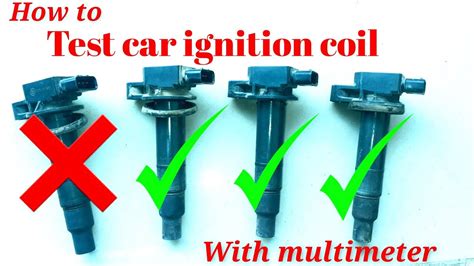How to Test an Ignition Coil: A Comprehensive Guide
Testing your ignition coil might seem daunting, but with the right tools and knowledge, it's a manageable DIY task. A faulty ignition coil can leave you stranded, so understanding how to test it can save you time and money. This guide provides a step-by-step approach, covering both visual inspection and electrical testing methods.
Why Test Your Ignition Coil?
Before diving into the testing process, let's understand why you might need to test your ignition coil in the first place. Common symptoms of a failing ignition coil include:
- Misfires: Your engine may misfire, resulting in rough idling, poor acceleration, or a noticeable loss of power.
- Difficulty Starting: The engine might struggle to start or crank over slowly.
- Engine Stalling: The engine may stall unexpectedly, especially at idle.
- Check Engine Light: A illuminated check engine light, often accompanied by a diagnostic trouble code (DTC) related to misfires, points towards a potential issue with the ignition coil.
Tools You'll Need
Before you begin, gather the necessary tools. You'll need:
- Multimeter: A digital multimeter is essential for electrical testing. Make sure it can measure resistance and voltage.
- Owner's Manual: Consult your vehicle's manual for specific coil location, testing procedures, and wiring diagrams.
- Safety Glasses: Protect your eyes from potential sparks.
- Wrench(es): To access the ignition coil, you may need various size wrenches depending on your vehicle.
- Screwdrivers: May be necessary to remove coil covers or connectors.
- Gloves: Protecting your hands is always a good idea.
Visual Inspection: The First Step
Before using your multimeter, perform a quick visual inspection of the ignition coil:
- Check for Physical Damage: Look for any cracks, burns, or melting on the coil itself or its wiring. Any visible damage is a strong indicator of a faulty component.
- Inspect Connectors: Examine the connectors for corrosion, loose connections, or broken wires. Clean any corrosion with a wire brush or contact cleaner.
Electrical Testing: Resistance and Voltage Checks
This is where your multimeter comes into play. Always disconnect the negative (-) battery terminal before starting any electrical testing.
1. Resistance Test:
This test checks the coil's primary and secondary windings for proper resistance. Your vehicle's manual should specify the expected resistance values.
- Locate the Coil's Terminals: Identify the primary and secondary terminals on your ignition coil. The manual will indicate their location.
- Measure Primary Resistance: Connect the multimeter leads to the primary terminals and measure the resistance. Compare your reading to the value specified in your owner's manual. A significantly higher or lower reading suggests a problem.
- Measure Secondary Resistance: Repeat the process for the secondary terminals, again comparing your reading to the manual's specifications.
2. Voltage Test (While Cranking):
This test checks if the coil is receiving the necessary voltage to operate correctly. This requires a helper.
- Connect the Multimeter: Set your multimeter to measure DC voltage. Connect the positive lead to the positive (+) battery terminal.
- Connect the Negative Lead: Connect the negative lead to one of the primary coil terminals.
- Have Someone Crank the Engine: Ask someone to crank the engine while you observe the multimeter reading. You should see a voltage spike. A lack of voltage indicates a problem in the ignition system before the coil.
Interpreting the Results
If your resistance readings are outside the manufacturer's specified range or you don't see a voltage spike during cranking, the ignition coil is likely faulty and needs replacement.
Replacing the Ignition Coil
Replacing an ignition coil usually involves disconnecting the electrical connectors, removing the mounting bolts, and installing the new coil in reverse order. Refer to your vehicle's service manual for specific instructions.
Remember, safety first! If you're uncomfortable performing these tests or the replacement, consult a qualified mechanic. Improper handling of automotive electrical systems can be dangerous.
